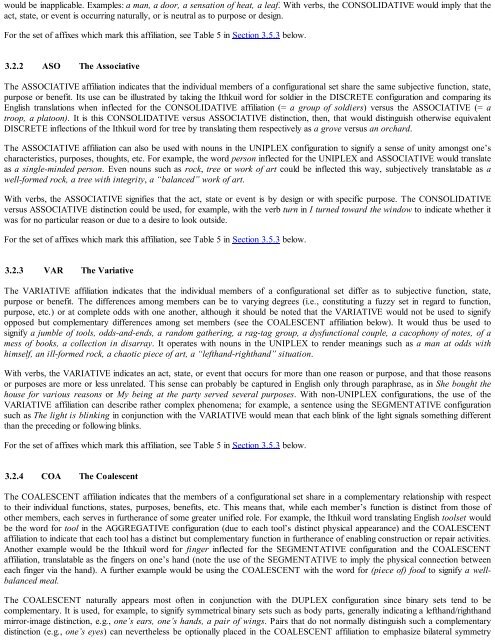logical language - Developers
logical language - Developers
logical language - Developers
Create successful ePaper yourself
Turn your PDF publications into a flip-book with our unique Google optimized e-Paper software.
would be inapplicable. Examples: a man, a door, a sensation of heat, a leaf. With verbs, the CONSOLIDATIVE would imply that the<br />
act, state, or event is occurring naturally, or is neutral as to purpose or design.<br />
For the set of affixes which mark this affiliation, see Table 5 in Section 3.5.3 below.<br />
3.2.2 ASO The Associative<br />
The ASSOCIATIVE affiliation indicates that the individual members of a configurational set share the same subjective function, state,<br />
purpose or benefit. Its use can be illustrated by taking the Ithkuil word for soldier in the DISCRETE configuration and comparing its<br />
English translations when inflected for the CONSOLIDATIVE affiliation (= a group of soldiers) versus the ASSOCIATIVE (= a<br />
troop, a platoon). It is this CONSOLIDATIVE versus ASSOCIATIVE distinction, then, that would distinguish otherwise equivalent<br />
DISCRETE inflections of the Ithkuil word for tree by translating them respectively as a grove versus an orchard.<br />
The ASSOCIATIVE affiliation can also be used with nouns in the UNIPLEX configuration to signify a sense of unity amongst one’s<br />
characteristics, purposes, thoughts, etc. For example, the word person inflected for the UNIPLEX and ASSOCIATIVE would translate<br />
as a single-minded person. Even nouns such as rock, tree or work of art could be inflected this way, subjectively translatable as a<br />
well-formed rock, a tree with integrity, a “balanced” work of art.<br />
With verbs, the ASSOCIATIVE signifies that the act, state or event is by design or with specific purpose. The CONSOLIDATIVE<br />
versus ASSOCIATIVE distinction could be used, for example, with the verb turn in I turned toward the window to indicate whether it<br />
was for no particular reason or due to a desire to look outside.<br />
For the set of affixes which mark this affiliation, see Table 5 in Section 3.5.3 below.<br />
3.2.3 VAR The Variative<br />
The VARIATIVE affiliation indicates that the individual members of a configurational set differ as to subjective function, state,<br />
purpose or benefit. The differences among members can be to varying degrees (i.e., constituting a fuzzy set in regard to function,<br />
purpose, etc.) or at complete odds with one another, although it should be noted that the VARIATIVE would not be used to signify<br />
opposed but complementary differences among set members (see the COALESCENT affiliation below). It would thus be used to<br />
signify a jumble of tools, odds-and-ends, a random gathering, a rag-tag group, a dysfunctional couple, a cacophony of notes, of a<br />
mess of books, a collection in disarray. It operates with nouns in the UNIPLEX to render meanings such as a man at odds with<br />
himself, an ill-formed rock, a chaotic piece of art, a “lefthand-righthand” situation.<br />
With verbs, the VARIATIVE indicates an act, state, or event that occurs for more than one reason or purpose, and that those reasons<br />
or purposes are more or less unrelated. This sense can probably be captured in English only through paraphrase, as in She bought the<br />
house for various reasons or My being at the party served several purposes. With non-UNIPLEX configurations, the use of the<br />
VARIATIVE affiliation can describe rather complex phenomena; for example, a sentence using the SEGMENTATIVE configuration<br />
such as The light is blinking in conjunction with the VARIATIVE would mean that each blink of the light signals something different<br />
than the preceding or following blinks.<br />
For the set of affixes which mark this affiliation, see Table 5 in Section 3.5.3 below.<br />
3.2.4 COA The Coalescent<br />
The COALESCENT affiliation indicates that the members of a configurational set share in a complementary relationship with respect<br />
to their individual functions, states, purposes, benefits, etc. This means that, while each member’s function is distinct from those of<br />
other members, each serves in furtherance of some greater unified role. For example, the Ithkuil word translating English toolset would<br />
be the word for tool in the AGGREGATIVE configuration (due to each tool’s distinct physical appearance) and the COALESCENT<br />
affiliation to indicate that each tool has a distinct but complementary function in furtherance of enabling construction or repair activities.<br />
Another example would be the Ithkuil word for finger inflected for the SEGMENTATIVE configuration and the COALESCENT<br />
affiliation, translatable as the fingers on one’s hand (note the use of the SEGMENTATIVE to imply the physical connection between<br />
each finger via the hand). A further example would be using the COALESCENT with the word for (piece of) food to signify a wellbalanced<br />
meal.<br />
The COALESCENT naturally appears most often in conjunction with the DUPLEX configuration since binary sets tend to be<br />
complementary. It is used, for example, to signify symmetrical binary sets such as body parts, generally indicating a lefthand/righthand<br />
mirror-image distinction, e.g., one’s ears, one’s hands, a pair of wings. Pairs that do not normally distinguish such a complementary<br />
distinction (e.g., one’s eyes) can nevertheless be optionally placed in the COALESCENT affiliation to emphasize bilateral symmetry


